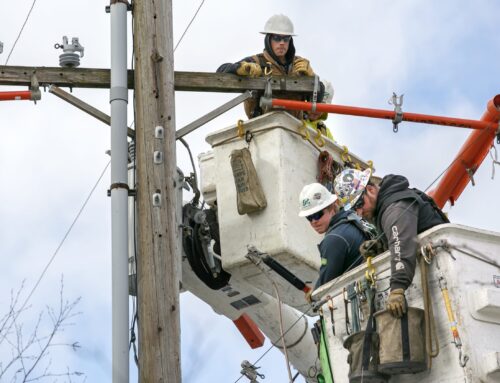Fee Records On The Bitcoin Network: What It Reveals
May 19, 2025
14h31 ▪
5
min read ▪ by
Evans S.
Spring 2025 may be mild, but the Bitcoin blockchain is heating up like never before. On Sunday, the BTC price once again nearly touched $106,000, awakening old FOMO reflexes. However, the loudest indicator isn’t the quotation, but these micro-amounts that add up: transaction fees. With a moving average of $2.40 — one dollar more than at the beginning of the month — they already break the annual record. Behind this apparent trifle lies an unfiltered snapshot of the network’s state and the psychology of its holders.

In Brief
- Average fees reach $2.40, a 2025 record, while transactions drop by 35%.
- Over 14M BTC sleep outside exchanges, reducing available supply and strengthening block space demand.
- Between recent halving and price near $106,000, a supply shock looms for the market.
Bitcoin: Fees Soaring While Transaction Counter Stalls
The first paradox jumps out: fewer transactions, but more expensive. Since the peak of 507,000 daily transfers on April 22, the pace has dropped by 35% to plateau around 330,000. Yet, the average cost is rising.
How to explain this big gap? First, blocks are no longer filled with simple P2P transfers. They now host heavier operations: Ordinals inscriptions, post-halving BRC-20 “runes,” off-chain swaps reconciled on-chain. Each operation occupies more bytes; therefore, fewer transactions are enough to saturate the available space.
Next, the April halving, by dividing miners’ subsidies, shifted remuneration towards fees.
Validators prioritize relaying packages offering the most generous fee. Result: the mempool looks like the line at an exclusive club; those who want to enter pay the bouncer. The mechanical increase in the entry ticket is thus not (only) a sign of mass adoption but also internal competition for a structurally scarcer space.
Finally, the price effect is fully at play. As long as BTC stays above $100,000, sending a few satoshis “only” costs the equivalent of a coffee. Psychologically, the user accepts this extra cost, convinced that the same BTC will be worth more tomorrow.
Start your crypto adventure safely with Coinhouse
This link uses an affiliate program.
Illiquid Supply: A Powder Keg Under Pressure
While fees are blazing, another metric flashes red: illiquid supply. Glassnode now records 14 million BTC in the hands of low-spenders, an all-time record. In other words, nearly two-thirds of circulating Bitcoin sleeps in wallets whose owners only touch the USB key, never the “send” button.
This scarcity of units available on platforms spawns a known scenario: the supply shock. If just a spark of demand is enough to empty order books, the fee surge becomes a prologue, not an epilogue. Traders clearly understand: this is not an exodus but a hodler sit-in, more unshakable than in the 2017 or 2021 episodes.
Moreover, Bitcoin’s dominance of the global market is regaining strength after a brief altcoin interlude. This rebound suggests that Bitcoin’s recent underperformance was more a liquidity redistribution than a paradigm shift. In other words, the “king” remains king; it just took a brief rest.
What Are the Consequences for Investors, Companies, and Users?
From a strategic point of view, these record fees are a large-scale stress test. Exchanges that delayed optimizing their transaction aggregators or deploying Taproot batch payments are now paying the heavy price. Conversely, those already using the Lightning Network reduce their costs and capture flows of users in a hurry.
For the long-term investor, the interpretation is twofold. Yes, high fees can scare newcomers. But they mostly show a living network, saturated with demands where miners remain incentivized to secure blocks even after rewards compression. Simply put, the higher the bill, the more the infrastructure proves its resilience.
Finally, individuals must adjust their habits: schedule their sends during mempool lows, favor wallets that finely estimate fees, or split their UTXOs before peak periods. Otherwise, they risk seeing half their micro-transaction vanish into satoshi dust.
In 2025, the term “fees” is no longer just a technical cost; it becomes an advanced indicator of Bitcoin protocol’s economic, social, and even psychological health. Every satoshi paid to miners tells a story: one of a supply that is becoming scarce, a demand that persists, and a digital asset that, despite sixteen years of existence, still manages to surprise. The next time you click “Send,” take a moment to contemplate those few cents… They might just trace the curve of the next bullish wave.
Maximize your Cointribune experience with our “Read to Earn” program! For every article you read, earn points and access exclusive rewards. Sign up now and start earning benefits.
Fascinated by Bitcoin since 2017, Evariste has continuously researched the subject. While his initial interest was in trading, he now actively seeks to understand all advances centered on cryptocurrencies. As an editor, he strives to consistently deliver high-quality work that reflects the state of the sector as a whole.
Search
RECENT PRESS RELEASES
Related Post



